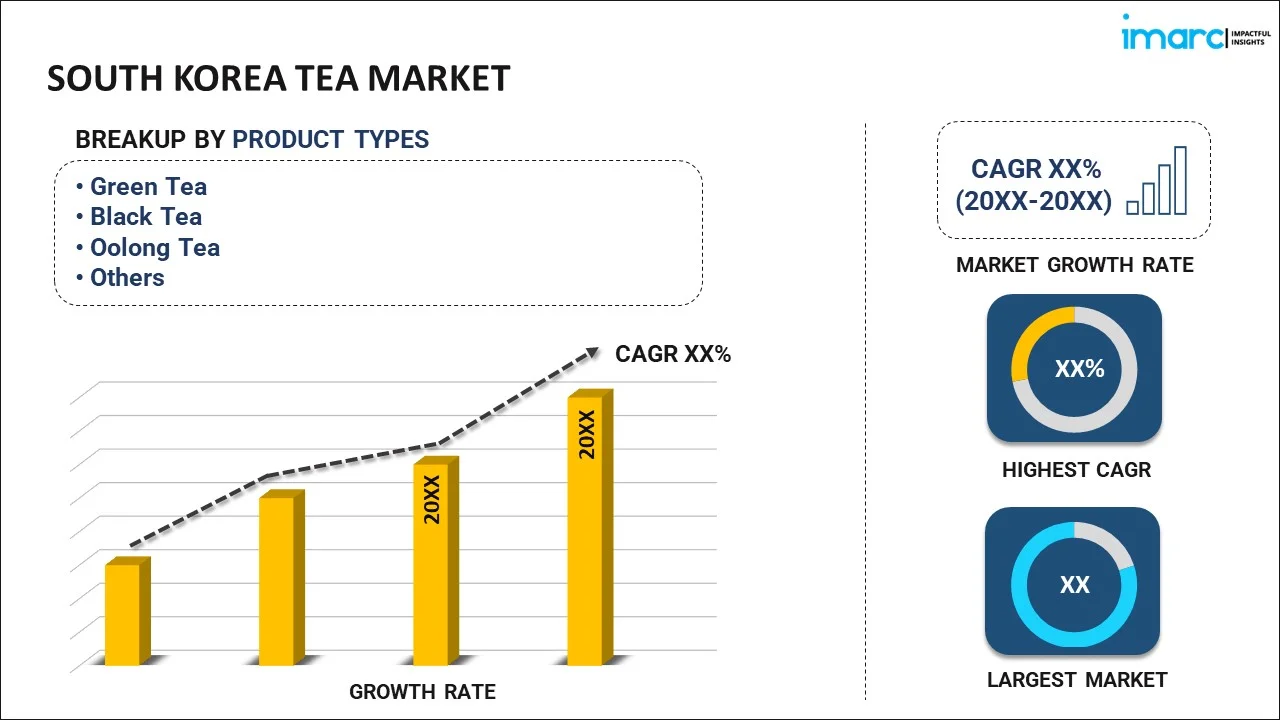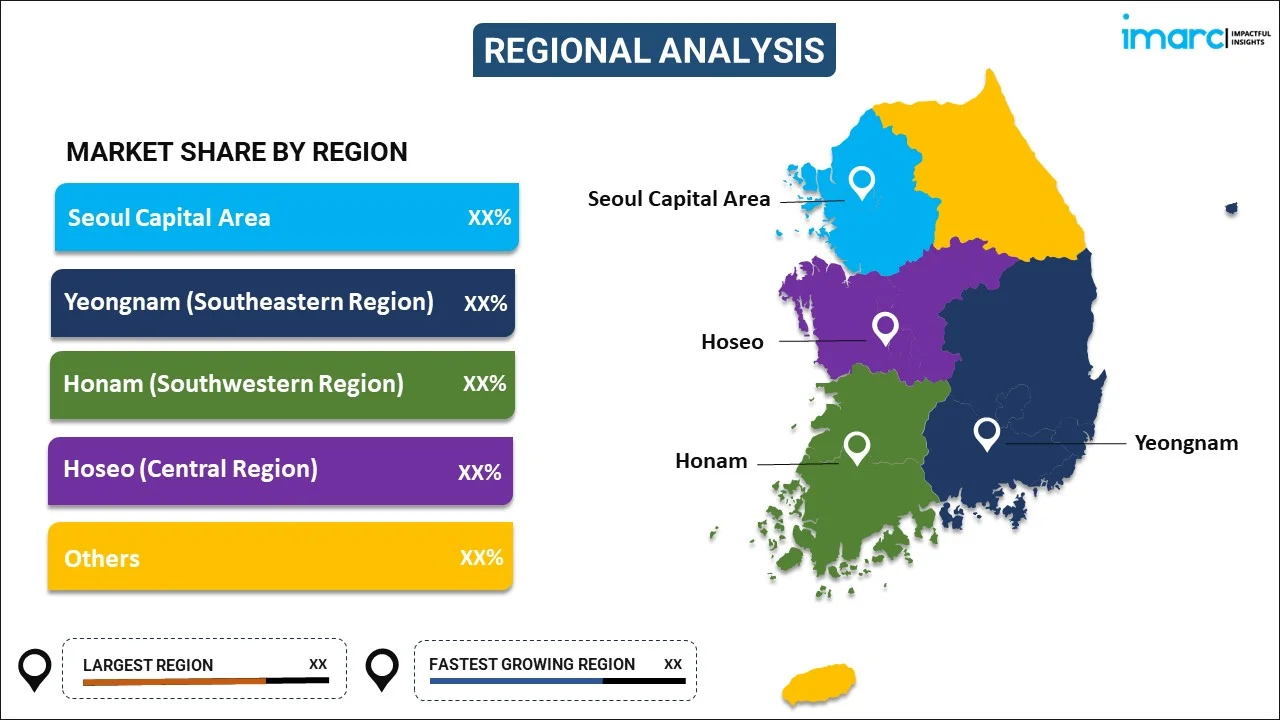
South Korea Tea Market Report by Product Type (Green Tea, Black Tea, Oolong Tea, and Others), Packaging (Plastic Containers, Loose Tea, Paper Boards, Aluminium Tin, Tea Bags, and Others), Distribution Channel (Supermarkets/Hypermarkets, Specialty Stores, Convenience Stores, Online, and Others), Application (Residential, Commercial), and Region 2025-2033
Market Overview:
South Korea tea market size reached USD 490.0 Million in 2024. Looking forward, IMARC Group expects the market to reach USD 730.0 Million by 2033, exhibiting a growth rate (CAGR) of 4.1% during 2025-2033. The increasing shifts in consumer preferences towards natural and organic products, which have led to an increased demand for specialty and premium teas, are driving the market.
|
Report Attribute
|
Key Statistics
|
|---|---|
|
Base Year
|
2024 |
|
Forecast Years
|
2025-2033
|
|
Historical Years
|
2019-2024
|
| Market Size in 2024 | USD 490.0 Million |
| Market Forecast in 2033 | USD 730.0 Million |
| Market Growth Rate (2025-2033) | 4.1% |
Tea, a beverage steeped in rich tradition and cultural significance, has transcended its origins to become a cherished elixir. Derived from the leaves of the Camellia sinensis plant, tea comes in various forms, each boasting unique flavors, aromas, and health benefits. Beyond its enticing taste, tea has woven itself into the fabric of societies, symbolizing hospitality, meditation, and social connection. The elaborate tea ceremonies exemplify the ritualistic appreciation for this ancient beverage, while the afternoon tea tradition reflects a refined and leisurely approach. Today, tea transcends cultural boundaries, uniting people over shared moments of respite and reflection. As a source of comfort, wellness, and cultural expression, tea continues to captivate the senses and enrich lives in many regions.
South Korea Tea Market Trends:
The tea market in South Korea is driven by several key factors, which collectively contribute to its dynamic growth and sustained popularity. Firstly, the regional trend towards healthier lifestyles has propelled the demand for tea, known for its various health benefits. Additionally, the rising awareness of the diverse range of tea flavors and types has expanded consumer preferences, fostering innovation and product development within the industry. Furthermore, the surge in online retail platforms has facilitated easy access to a myriad of tea options for consumers, thereby enhancing market penetration. The interconnected nature of the economy has also enabled the exchange of traditional tea varieties across regions, contributing to a rich tapestry of choices for consumers in South Korea. Moreover, the growing importance of sustainability and ethical sourcing practices has spurred the demand for organic and fair-trade teas, steering the market towards more socially responsible avenues. In tandem with these factors, the evolving tea culture, marked by the emergence of specialty tea cafes and the integration of tea into various culinary experiences, is also expected to drive the tea market in South Korea during the forecast period.
South Korea Tea Market Segmentation:
IMARC Group provides an analysis of the key trends in each segment of the market, along with forecasts at the country level for 2025-2033. Our report has categorized the market based on product type, packaging, distribution channel, and application.
Product Type Insights:

- Green Tea
- Black Tea
- Oolong Tea
- Others
The report has provided a detailed breakup and analysis of the market based on the product type. This includes black tea, green tea, oolong tea, and others.
Packaging Insights:
- Plastic Containers
- Loose Tea
- Paper Boards
- Aluminium Tin
- Tea Bags
- Others
A detailed breakup and analysis of the market based on the packaging have also been provided in the report. This includes plastic containers, loose tea, paper boards, aluminium tin, tea bags, and others.
Distribution Channel Insights:
- Supermarkets/Hypermarkets
- Specialty Stores
- Convenience Stores
- Online
- Others
The report has provided a detailed breakup and analysis of the market based on the distribution channel. This includes supermarkets/hypermarkets, specialty stores, convenience stores, online, and others.
Application Insights:
- Residential
- Commercial
A detailed breakup and analysis of the market based on the application have also been provided in the report. This includes residential and commercial.
Regional Insights:

- Seoul Capital Area
- Yeongnam (Southeastern Region)
- Honam (Southwestern Region)
- Hoseo (Central Region)
- Others
The report has also provided a comprehensive analysis of all the major regional markets, which include Seoul Capital Area, Yeongnam (Southeastern Region), Honam (Southwestern Region), Hoseo (Central Region), and Others.
Competitive Landscape:
The market research report has also provided a comprehensive analysis of the competitive landscape. Competitive analysis such as market structure, key player positioning, top winning strategies, competitive dashboard, and company evaluation quadrant has been covered in the report. Also, detailed profiles of all major companies have been provided.
South Korea Tea Market Report Coverage:
| Report Features | Details |
|---|---|
| Base Year of the Analysis | 2024 |
| Historical Period | 2019-2024 |
| Forecast Period | 2025-2033 |
| Units | Million USD |
| Scope of the Report | Exploration of Historical Trends and Market Outlook, Industry Catalysts and Challenges, Segment-Wise Historical and Future Market Assessment:
|
| Product Types Covered | Green Tea, Black Tea, Oolong Tea, Others |
| Packagings Covered | Plastic Containers, Loose Tea, Paper Boards, Aluminium Tin, Tea Bags, Others |
| Distribution Channels Covered | Supermarkets/Hypermarkets, Specialty Stores, Convenience Stores, Online, Others |
| Applications Covered | Residential, Commercial |
| Regions Covered | Seoul Capital Area, Yeongnam (Southeastern Region), Honam (Southwestern Region), Hoseo (Central Region), Others |
| Customization Scope | 10% Free Customization |
| Post-Sale Analyst Support | 10-12 Weeks |
| Delivery Format | PDF and Excel through Email (We can also provide the editable version of the report in PPT/Word format on special request) |
Key Questions Answered in This Report:
- How has the South Korea tea market performed so far and how will it perform in the coming years?
- What has been the impact of COVID-19 on the South Korea tea market?
- What is the breakup of the South Korea tea market on the basis of product type?
- What is the breakup of the South Korea tea market on the basis of packaging?
- What is the breakup of the South Korea tea market on the basis of distribution channel?
- What is the breakup of the South Korea tea market on the basis of application?
- What are the various stages in the value chain of the South Korea tea market?
- What are the key driving factors and challenges in the South Korea tea?
- What is the structure of the South Korea tea market and who are the key players?
- What is the degree of competition in the South Korea tea market?
Key Benefits for Stakeholders:
- IMARC’s industry report offers a comprehensive quantitative analysis of various market segments, historical and current market trends, market forecasts, and dynamics of the South Korea tea market from 2019-2033.
- The research report provides the latest information on the market drivers, challenges, and opportunities in the South Korea tea market.
- Porter's five forces analysis assist stakeholders in assessing the impact of new entrants, competitive rivalry, supplier power, buyer power, and the threat of substitution. It helps stakeholders to analyze the level of competition within the South Korea tea industry and its attractiveness.
- Competitive landscape allows stakeholders to understand their competitive environment and provides an insight into the current positions of key players in the market.
Need more help?
- Speak to our experienced analysts for insights on the current market scenarios.
- Include additional segments and countries to customize the report as per your requirement.
- Gain an unparalleled competitive advantage in your domain by understanding how to utilize the report and positively impacting your operations and revenue.
- For further assistance, please connect with our analysts.
 Inquire Before Buying
Inquire Before Buying
 Speak to an Analyst
Speak to an Analyst
 Request Brochure
Request Brochure
 Request Customization
Request Customization




.webp)




.webp)












